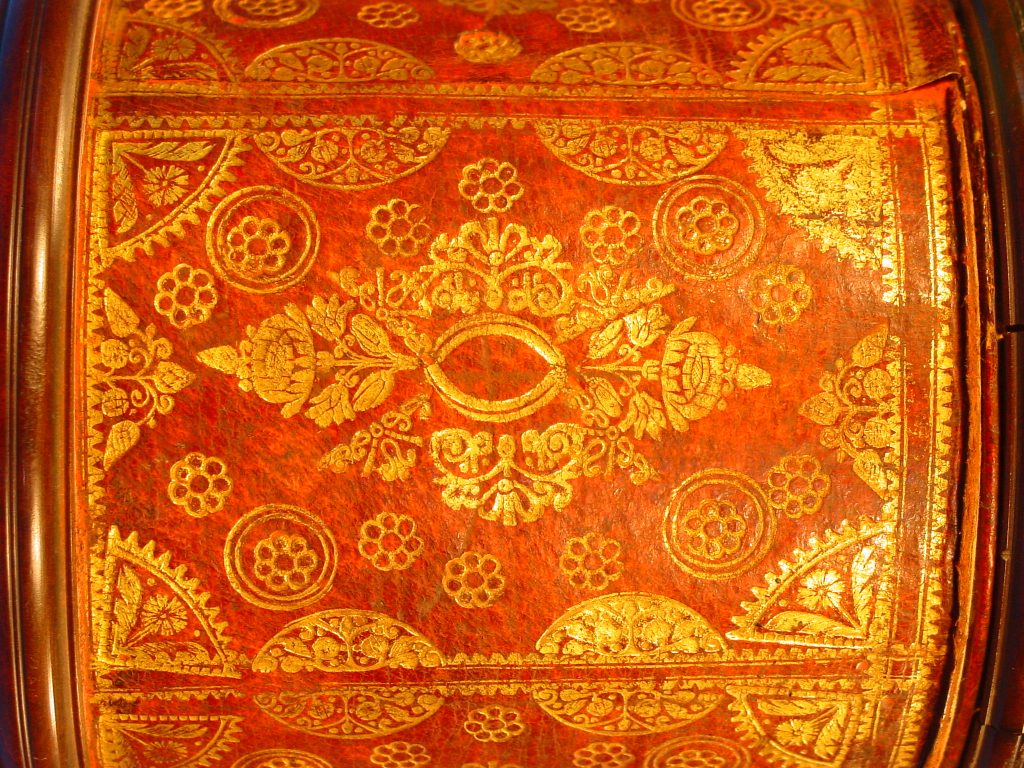
Year/Period |
1680-1700 |
Maker |
MARSHALL |
Country |
United Kingdom |
Signature |
Unsigned |
Category |
Microscopes |
Optical 1 |
Compound |
Optical 2 |
Non-achromatic |
Size of the box (h x w x d) |
58 × 25.5 × 27.5 cm |
Size of the microscope (h x w x d) |
44 × 20.5 × 16.5 cm |
Inventory number |
SM 1 |
With the microscope goes a pyramidal pine box with a lock and a brass button (the latter is a later addition). The door has wooden pin and hole hinges, the pins are a part of the door.
The stem of the microscope is mounted on a veneered octagonal oaken box with drawer. On the stem an adjustable brass sleeve which carries the flat stage, this sleeve can be fixed by means of a screw. A second sleeve carries a holder for the body tube. Fine adjustment is by screwing the body tube up or down in this holder. There is a hole for a (missing) mirror in the top of the box.
The outer body-tube is made of cardboard which is covered by red (morocco) leather. The top and bottom are provided with lignum vitae end pieces, below a flange and snout carrying the objective lens. On the top a simple ring.
The leather is embossed with four similar gold tooled designs. These are made up of a large number of stamps, which have been analysed on a number of microscopes from the same period by Gerard Turner in 1966 (see reference below).
Motives on this microscope are:
Rim: Roll 1, a dog-toothed motif.
Four corners: Turner 31, in a quadrant a flower with two leaves.
Middle top and below: Turner 46, triangular cluster of fruit.
Left and right: Turner 25, a half ellipse with floral motives inside, twice.
Around the central design: Turner 58, a circular motif surrounded by a rim of seven small circles, in every quarter, there are ten of these circular designs.
Around the central design: Turner 1, a double circular motif in which Turner 58 is stamped, in every quarter, there are four of these designs.
The central motif of the four parts consists of:
Left and right: Turner 5, a crown on leaves.
Top and below: Turner 11, a floral motif.
Crosswise: Turner 15.
Central motif: Turner 3, two double circle segments.
When Gerard Turner saw this microscope he told dr. ir. J.C. Deiman this was the most elaborate design he had ever seen on such an instrument.
There is one objective lens left, mounted in ebony, it is fixed in its mount by a spring washer. A second mount is empty. The lens having a diameter of 8 mm, is 3.07 mm thick. It is plano-convex, with its convex side mounted downwards. The lens is not well polished, its rim is faceted.
The focal length is 9.54 mm and the measured numerical aperture is 0.08. From this follows a theoretical resolving power of ca. 4.5 µm.
It was possible to measure the magnification and the resolving power using the usual Bleeker microscope with a 185 mm body tube and a 5× Huygenian eye piece. The magnification was 86.6× and the resolving power 6.5 µm.
The star test shows irregularly shaped rings and bad contrast, for which the bad quality of the polishing is responsible.
The eyepiece is mounted in lignum vitae, it goes with an inner tube made of cardboard. Its height can be adjusted in the outer tube, there are marks for the different objective lenses. Unfortunately, there are no lenses in the eyepiece.
Literature
Turner, G. L’Estrange, ‘Decorative Tooling on 17th and 18th Century Microscopes and Telescopes’, in: Physis: Rivista internazionale di storia della scienza, 8 (1966), p. 99-128. Also in: Turner GL’E, Essays on the History of the Microscope, Senecio, Oxford, 1980, p. 79-108.